- 16.06.2023
- News
Disposable electronic cigarettes do not comply with standards currently in force
A large number of disposable electronic cigarettes are marketed in flagrant violation of the law. A large proportion of these products, probably around half, contain reservoirs of e-liquid that exceed the legal limit of 2 milliliters in volume. The competent authorities in Switzerland do not seem to be controlling these before or after they are placed on the market.
In England, where the same limits are in place, the authorities have intervened to remove these products from the market and prosecute the responsible importers and retailers. We ask that the Swiss authorities intervene urgently in the same manner, because this is about the protection of our youth, given the enormous popularity of these products among adolescents.
Legal framework
Under article 16a of the federal law of 6 October 1995 on technical barriers to trade (LETC)[1], embodying in Swiss law the "Cassis de Dijon" principle, products that do not comply with Swiss regulations but meet the technical requirements of the European Union (EU) or meet those of at least one Member State of the EU or the European Economic Area (EEA) and are legally on the market of such State, may consequently be marketed in Switzerland[2].
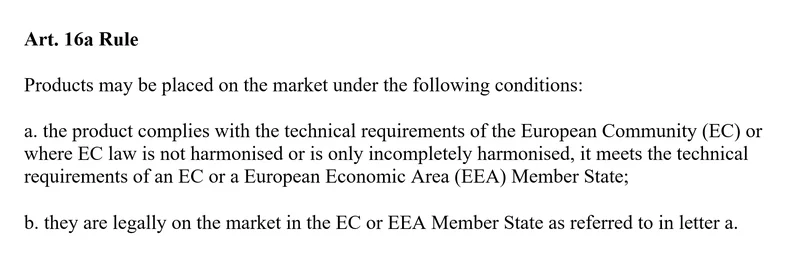
*Translation: AT Switzerland
Currently – and pending the entry into force of the new Tobacco Products Act[3] – electronic cigarettes and e-liquids containing nicotine still fall within the scope of the Food Act (LDAl) and its prescriptions as everyday objects coming into contact with the mucous membranes, the skin, or the hair and capillary systems[4].
Under this legislation, everyday objects cannot contain substances such as nicotine that confer pharmacological effects. Thus, the Food Safety and Veterinary Office (FSVO) had prohibited by general decision the import of electronic cigarettes and e-liquids containing nicotine[5]. But in April 2018, the FSVO decision was cancelled by the Federal Administrative Court because, according to the opinion of the court, it was vitiated by a serious formal defect[6]. Since then, no new decision has been issued by the FSVO.
As a result of this court judgement, electronic cigarettes with nicotine are marketed pursuant to European Directive 2014/40/EU, which harmonises the rules of the Member States with regard to the manufacture, presentation, and sale of tobacco and related products[7].
According to this Directive, the nicotine content of the liquid of electronic cigarettes cannot exceed 20 mg/ml, (often indicated as a percentage of 2%)[8]. In addition to the content limit, the volume of the refill bottles cannot exceed 10 ml of liquid containing nicotine, while the volume of liquid containing nicotine in the cartridge of disposable electronic cigarettes or single-use cartridges cannot exceed 2 ml[9].
In this respect, article 9 of the new federal law of 1 October 2021 on tobacco products and electronic cigarettes (Tobacco Products Act, LPTab), which should come into force in mid-2024, fully incorporates the limits of the Directive.

*Translation: AT Switzerland
The Directive also provides that neither the labelling nor the tobacco product itself may include any element or device, whether in the form of a message, symbol, name, trade mark, figurative sign, or other, which "contributes to the promotion of a tobacco product or induces its consumption by giving an erroneous impression as to the characteristics, health effects, risks, or emissions of the product […]” or which “conjures up a taste, an odour, any aroma, or any other additive or the absence thereof”[10].
The manufacturer or importer have the responsibility to notify the competent authorities of the Member State at least six months before the date of the planned placement of an electronic cigarette on the market[11].
In addition, the Directive also orders that electronic cigarettes must be accompanied by a leaflet presenting the instructions for use, contraindications and warnings, possible adverse effects, the addictive effect, toxicity, as well as contact details of the manufacturer or importer and of a natural or legal person within the Union. The leaflet should also include a note indicating that the use of the product is not recommended for young people and non-smokers[12].
Finally, the packaging must include details of all ingredients, the nicotine content and quantity released per dose, the batch number, a recommendation to keep the product out of the reach of children, and one of the health warnings listed in the Directive[13].
Only when the conditions imposed by the European Directive are met can an electronic cigarette be marketed in the European Union, and by extension, in Switzerland.
Current situation on the Swiss market
Despite clear regulations, our many observations of single-use or disposable electronic cigarettes on the Swiss market show that these conditions are not currently respected. Therefore, a very significant number of these products (which we estimate could reach more than half of all products of this type) are sold in Switzerland illegally.
Exceeding the maximum authorised nicotine content (20mg/ml) as well as exceeding the maximum authorised volume (2 ml) are among the main shortcomings that we observe. But non-compliance with the provisions of the Directive concerning labelling are also frequent, in particular the promotion of the consumption of an electronic cigarette or evoking tastes, aromas, or other characteristics.
Finally, it is not uncommon to find products that do not contain the information leaflet or do not bear on the packaging the indications imposed by the Directive.
Exceeding the maximum authorised nicotine content
Research undertaken by AT-Switzerland in 2022 showed that a large number of disposable electronic cigarettes on the retail market or sold online in Switzerland had nicotine levels far exceeding the authorised maximum[14].

Image : AT Switzerland
In the meantime, AT found that one of the online sellers indicates on its site that it has changed its practice and now only sells products respecting the maximum nicotine content of 2%[15].
However, other disposable e-cigarette reseller sites continue to offer products with rates exceeding the authorised limits. The two online shops below not only use a “.ch” domain name, but are also operated by companies headquartered in Switzerland.
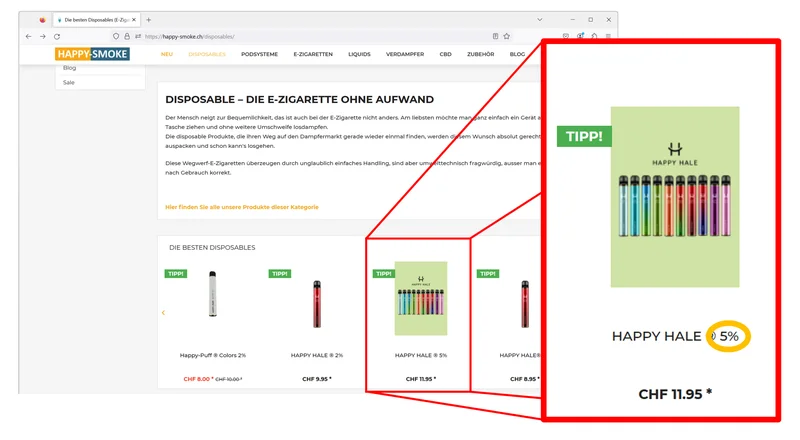
Source: Happy-smoke.ch
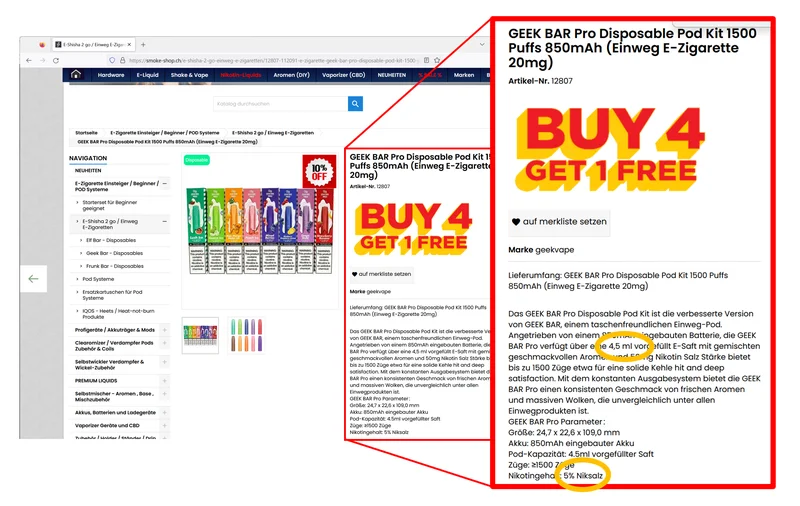
Source: Smoke-shop.ch
Even when the content displayed on the outer packaging respects the legal limit, can we really trust this claim? In view of recent experiences with manufacturers and retailers of electronic cigarettes, the consumer would have the right to doubt it. Several studies have found that deviations of more than 10%, or even 20%, from the nicotine levels indicated are frequent[16]. The cantonal laboratory of Basel-City confirmed deviations in Switzerland by its own observations in 2022[17].
At the beginning of 2023, analyses ordered by the supervisory authority in the United Kingdom revealed numerous excesses of authorised content limits, resulting in numerous withdrawals of products from the market. In the first half of 2022 alone, 1.4 tonnes of disposable e-cigarettes were seized in the north of England[18].
In addition, data collected in the United States shows that in the last five years, the nicotine levels displayed in liquids have doubled. The market share of products whose content exceeds 5% even exploded from 0.7% to more than 67%. Throughout this period, the market share of liquids or electronic cigarettes without nicotine has never exceeded 1%[19]. Also in the United States, a majority of young people questioned in a recent study did not know that the electronic cigarettes they consumed contained nicotine; they thought they were only consuming flavours[20].
Exceeding the maximum authorised volume
In December 2022, the Swiss-French television consumer protection programme, "À Bon Entendeur", presented the results of their own investigations into disposable electronic cigarettes, reporting that eight of 15 samples of disposable electronic cigarettes had volumes greater than that authorised, i.e. more than 2 ml[21].

Source : RTS
In June 2023, AT Switzerland also observed in retail stores that many products could be purchased whose indicated volume exceeded the legal limit.
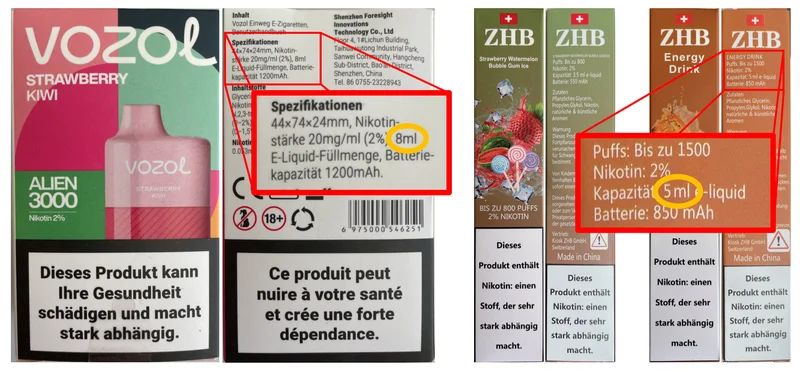

Source : AT Switzerland
Moreover, electronic cigarettes boasting a number of puffs surpassing 600 to 800 hardly comply with the volume constraints of the European Directive. The retailers themselves point this out[22]. The UK vaping industry umbrella considers that if an e-cigarette is present and claims to contain more than 800 puffs, it should be assumed that it contains more than 2 ml of liquid and therefore, its marketing on the British market would be prohibited[23].
Other violations of the Directive observed
Many packages do not carry the necessary legal indications or do not contain the leaflets with the mandatory information such as instructions for use, contraindications and warnings, adverse effects, or contact details of the manufacturer or importer.
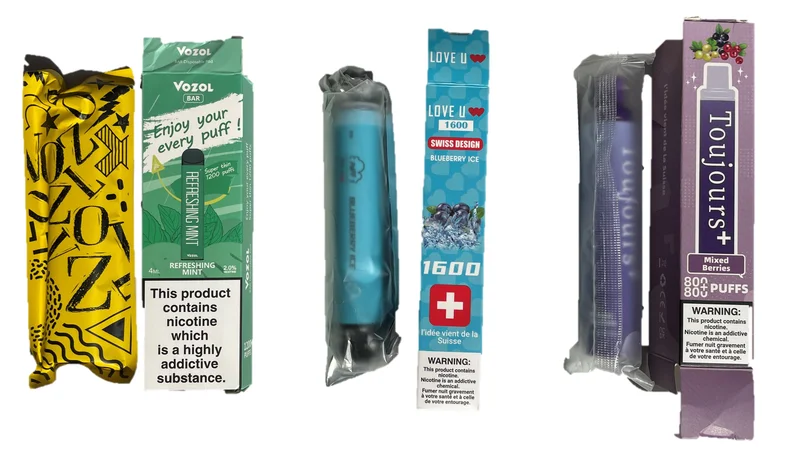
Source : AT Switzerland
Finally, the marketing practice of indicating the number of puffs and the aroma, as well as the printing of an image illustrating the aroma on the packaging which often accompanies it, should in any case be considered prohibited by the Directive. Indeed, by giving rise to an erroneous expectation as to the characteristics of the disposable cigarette or evoking a taste, an odour, or any aroma, they are likely to “contribute to the promotion […] or encourage its consumption”[24].
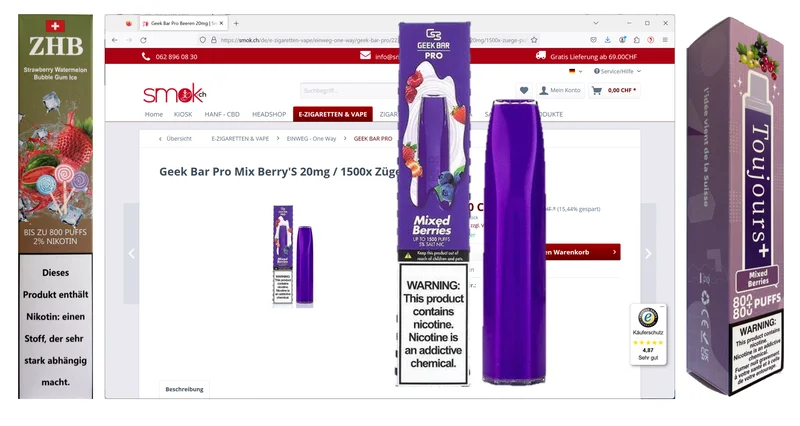
Source : AT Switzerland & Smok.ch
In conclusion, the Swiss market for disposable electronic cigarettes resembles a “Wild West” whose sheriff is dozing on his veranda. The self-regulation promised by the tobacco and nicotine industry has clearly failed and the lack of monitoring and sanctions doesn’t inspire confidence in the safety of these products. The law on tobacco products containing these limits, coming into force in 2024, will probably not change anything, because a law without control or sanctions is of absolutely no use.
[1] (RS 946.51)
[2] For a detailed explanation, see the Message of 30 November 2018 concerning the Federal Law on Tobacco Products and Electronic Cigarettes (Tobacco Products Act, LPTab), FF 2019 899, ch. 1.1.2. https://www.fedlex.admin.ch/filestore/fedlex.data.admin.ch/eli/fga/2019/169/fr/pdf-a/fedlex-data-admin-ch-eli-fga-2019-169-fr-pdf-a.pdf.
[3] FOPH, Prohibition of advertising for tobacco products and electronic cigarettes that reaches minors, Press release of 24 May 2023, Bern. https://www.bag.admin.ch/bag/fr/home/das-bag/aktuell/medienmitteilungen.msg-id-95383.html.
[4] Article 61 of the Ordinance on foodstuffs and everyday objects (ODAlOUs: RS 817.2) in combination with article 5 LDAi (RS 817.0).
[5] Decision of 12 November 2015 of the Federal Food Safety and Veterinary Office (FSVO) concerning electric cigarettes, electronic cigarettes, or e-cigarettes, FF 2015 7090.
[6] Judgement C-7634/2015 of the Federal Administrative Court of 24 April 2018. https://entscheide.weblaw.ch/cache.php?link=24-04-2018-C-7634-2015.
[7] Directive 2014/40/EU of the European Parliament and of the Council of 3 April 2014 on the approximation of the laws, regulations, and administrative provisions of the Member States relating to the manufacture, presentation and sale of tobacco products and related products, and repealing Directive 2001/37/EC, OJ L 127 of 29 April 2014, p. 1. https://eur-lex.europa.eu/legal-content/FR/TXT/PDF/?uri=CELEX:02014L0040-20150106.
[8] Art. 20, para. 3 let. b of Directive 2014/40/EU. See the explanations of the FSVO on electronic cigarettes: https://www.blv.admin.ch/blv/fr/home/gebrauchsgegenstaende/e-zigaretten.html.
[9] Art. 20, par. 3, let. a of the Directive 2014/40/UE.
[10] Art. 13 of the Directive 2014/40/UE.
[11] Art. 20, par. 2 of the Directive 2014/40/UE.
[12] Art. 20, par. 4, let. a of the Directive 2014/40/UE.
[13] Art. 20, par. 4, let. b of the Directive 2014/40/UE.
[14] AT Switzerland, Information Note: Puff Bars and other disposable cigarettes, March 2022, p. 11. https://www.at-schweiz.ch/userfiles/files/Downloads/Factsheets/2022%2011%2022%20BRIEF_Puff_Bar_FR_v2022_03_24.pdf.
[15] According to an annotation in a footnote on their site: "[Because of] The requirements applicable in Switzerland to electronic cigarettes, we no longer sell electronic cigarettes with 5% nicotine. All of our products currently on sale contain 2% nicotine. The requirements applicable in Switzerland to electronic cigarettes containing nicotine are those of the European Directive 2014/40 / EU, which defines in particular that liquids containing nicotine do not contain nicotine beyond 20 mg / ml (i.e. 2% maximum) [sic]". https://puffplus.ch/de/.
[16] Scott Appleton et al., "Market survey of disposable e-cigarette nicotine content and e-liquid volume,” BMC Public Health 22, Nr. 1 (2022), https://doi.org/10.1186/s12889-022-14152-2; Amelia Taylor, Keeley Dunn, und Sophie Turfus, "A review of nicotine-containing electronic cigarettes: Trends in use, effects, contents, labelling accuracy and detection methods,” Drug Testing and Analysis 13, Nr. 2 (2021), https://doi.org/10.1002/dta.2998; Kelly Buettner-Schmidt, Donald R. Miller, und Narayanaganesh Balasubramanian, „Electronic Cigarette Refill Liquids: Child-Resistant Packaging, Nicotine Content, and Sales to Minors,” Journal of pediatric nursing 31, Nr. 4 (2016), https://doi.org/10.1016/j.pedn.2016.03.019.
[17] Dr. Franz Dussy, Fabian Heule, „E-Liquids.: Nikotingehalt, nicht erlaubte Inhaltstoffe, Deklaration, Warnhinweise, Konformität mit dem Lebensmittel- und Chemikaliengesetz,” Gemeinsame Kampagne der Kantone Aargau, Basel-Landschaft, Bern, Solothurn und Basel-Stadt (Schwerpunktslabor) Gesundheitsdepartement des Kantons Basel-Stadt, Kantonales Laboratorium, zuletzt geprüft am 02.06.2023, https://www.gd.bs.ch/nm/2022-viele-e-liquids-zu-beanstanden-gd.html, Seite 2 (Ausgangslage).
[18] Sarah Marsh, "Some ‘nicotine-free’ vapes high in addictive substances, tests reveal: Concerns raised after some brands sold in shops in England and Wales found to exceed legal limits,” The Guardian, 16 April 2023, zuletzt geprüft am 17 April 2023, https://www.theguardian.com/society/2023/apr/16/some-nicotine-free-vapes-high-addictive-substances-tests-show.
[19] Alexa R. Romberg et al., "Patterns of nicotine concentrations in electronic cigarettes sold in the United States, 2013-2018,” Drug and alcohol dependence 203 (2019), https://doi.org/10.1016/j.drugalcdep.2019.05.029.
[20] Jeffrey G. Willett et al., "Recognition, use and perceptions of JUUL among youth and young adults,” Tobacco Control 28, Nr. 1 (2019), https://doi.org/10.1136/tobaccocontrol-2018-054273; Romberg et al., "Patterns of nicotine concentrations in electronic cigarettes sold in the United States, 2013-2018.”
[21] Linda B. Stéphane Fontanet, « Les ‘puffs’, cigarettes électroniques jetables, sont bourrées de substances irritantes, » Radio Télévision Suisse, 23 November 2022, contrôlé pour la dernière fois le 26 May 2023. https://www.rts.ch/info/suisse/13566372-les-puffs-cigarettes-electroniques-jetables-sont-bourrees-de-substances-irritantes.html.
[22] Are Disposable Vapes Legal in the UK? Easytek LTD (t/a Vape Superstore), 11 April 2022. https://www.vapesuperstore.co.uk/blogs/news/are-disposable-vapes-legal-in-the-uk.
[23] If in doubt, check it out: The UKVIA guide to compliant retailing of disposable vape products in the UK. UK Vaping Industry Association (UKVIA). https://www.ukvia.co.uk/wp-content/uploads/2021/09/updated-13th-Sep-UKVIA-If-in-doubt-check-it-out-information.pdf.
[24] Art. 20, al. 4, let. b, in combination with article 13, Directive 2014/40/UE. https://eur-lex.europa.eu/legal-content/FR/TXT/PDF/?uri=CELEX:02014L0040-20150106.